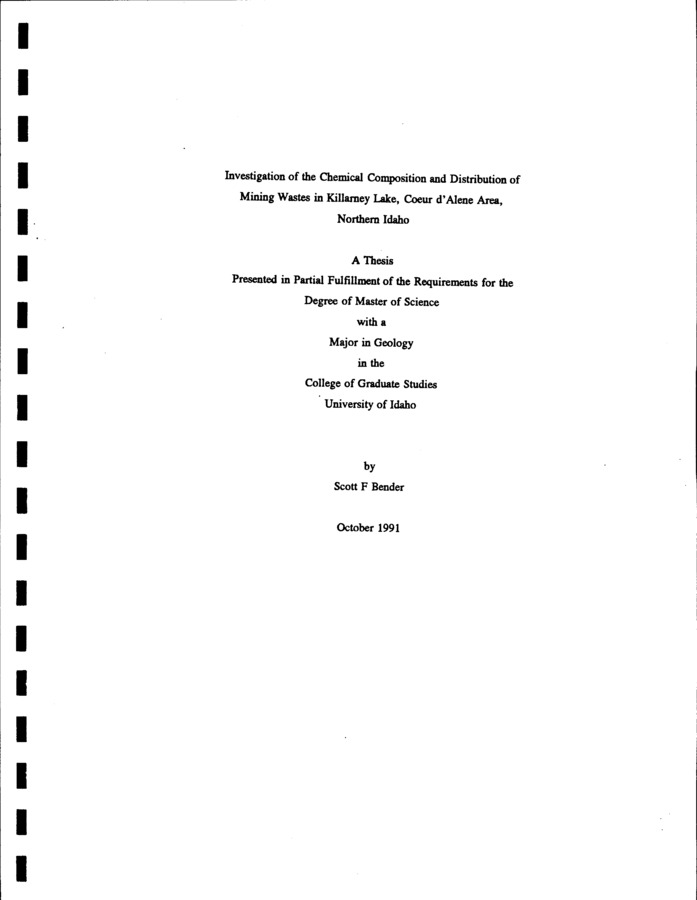PDF
Investigation of the chemical composition and distribution of mining wastes in Killarney Lake, Coeur d'Alene Area, Northern Idaho Item Info
- Title:
- Investigation of the chemical composition and distribution of mining wastes in Killarney Lake, Coeur d'Alene Area, Northern Idaho
- Authors:
- Bender, Scott F.
- Contributors:
- Idaho Water Resources Research Institute; IWRRI
- Date:
- 1991-10
- Description:
- Killarney Lake, a lateral lake of the Coeur d'Alene River in northern Idaho, received mining and milling wastes from the Coeur d'Alene mining district for nearly 100 years. Mining and milling wastes were transported by the river during flood events until 1968 when tailings ponds were built. Lake bed sediments in Killarney Lake were sampled at three separate localities using a piston core sampler operated from a raft. The cores collected 3.6 m and 3.5 m of lake bottom sediments from the north and south ends of the lake, respectively, and 6.4 m of sediments from the center of the lake. Lake bed sediments were also sampled to a depth of 59 em using a freezer box sampler. A control core and freezer box section were extracted from Bells Lake in the nearby St. Joe River drainage, an area free of commercial mining practices. Identification of the Mazama ash, which was collected at 6.1 m below lake bottom in Killarney Lake and 3.8 m below lake bottom in Bells Lake, by microprobe analysis enabled the chronology of cores from both lakes to be constrained. The lake bottom sediments were sampled to. evaluate heavy metal concentrations downstream of the mining district. Sediments were analyzed by atomic absorption spectrometry for As, Ag, Cd, Cu, Fe, Mn, Ni, Pb, and Zn. Sediments from Bells Lake showed similar chemistry to the pre-mining sediments in Killarney Lake, suggesting that Bells Lake was an adequate control. High concentrations of heavy metals are present in the top 59 em of the Killarney Lake bed at the center and deepest portion of the lake. Up to 17.5 em of metallic silt were collected at the north and south ends of the lake. The highest observed metal concentrations in the sediment were 376 ppm As, 37 ppm Ag, 475 ppm Cu, 146 ppm Cd, 111,000 ppm Fe, 13,440 ppm Mn, 71 ppm Ni, 37,400 ppm Pb, and 32,850 ppm Zn. In this uppermost layer, concentrations of metals are 1 to 3 orders of magnitude greater than in deeper Killarney Lake sediments or in Bells Lake. A sharp, defined contact was observed between the natural organic silt and the introduced metallic silt. Organic silt was also observed overlying the metallic silt in the freezer box sample. Sediments with heavy metal concentrations above that of background were found to occur a maximum of 22.5 em below the lower metallic silt and organic silt contact.
- Subjects:
- mine wastes sediments heavy metals
- Location:
- Killarney Lake; Coeur d'Alene River
- Idaho County:
- Kootenai County
- Latitude:
- 47.52
- Longitude:
- -116.56
- Collection:
- Coeur d'Alene Basin
- Source:
- Idaho Water Resources Research Institute, University of Idaho
- Identifier:
- IWRRI Number 199101
- Publisher:
- Idaho Water Resources Research Institute, University of Idaho
- Contributing Institution:
- University of Idaho
- Type:
- Text
- Format:
- application/pdf
- Cataloger:
- wbv
- Date Digitized:
- 2012
- Language:
- eng
Source
- Preferred Citation:
- "Investigation of the chemical composition and distribution of mining wastes in Killarney Lake, Coeur d'Alene Area, Northern Idaho", Idaho Waters Digital Library, University of Idaho Library Digital Collections, https://www.lib.uidaho.edu/digital/iwdl/items/iwdl-cda_bender_1991.html
Rights
- Rights:
- In copyright, educational use permitted. Educational use includes non-commercial reproduction of text and images in materials for teaching and research purposes. For other contexts beyond fair use, including digital reproduction, please contact the University of Idaho Library Special Collections and Archives Department at libspec@uidaho.edu. The University of Idaho Library is not liable for any violations of the law by users.
- Standardized Rights:
- http://rightsstatements.org/vocab/InC-EDU/1.0/

